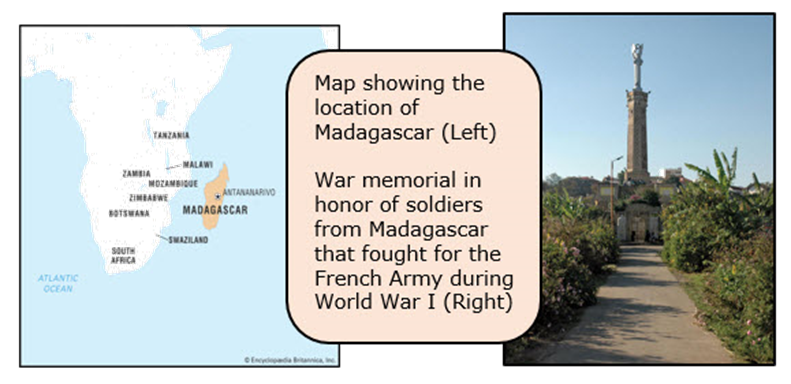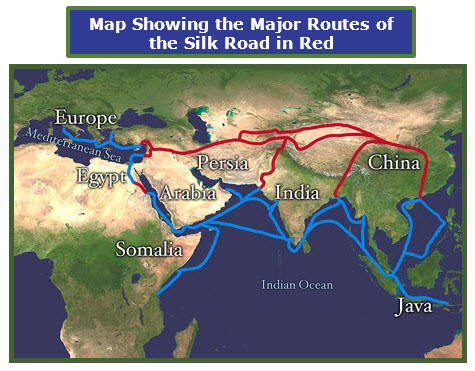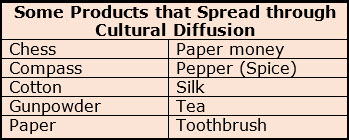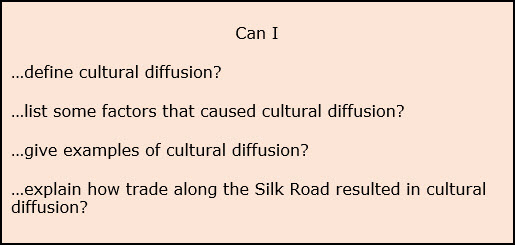CHANGE THROUGH CULTURAL DIFFUSION

Unit
Overview
People
move to different places for political, social, environmental, and economic
reasons. When they do, their languages,
traditions, ideas, and products go with them.
As they spread from one place to another, these concepts blend into
cultures where they were previously unknown.
They change the way people live, work, think, and behave. Let’s see how it all happens.
How
Products and Ideas Spread
Products,
traditions, and ideas move from one place to another just like people do. The spread of these things across great
distances is called cultural diffusion. It is responsible for our knowledge of the
great religions of the world, our style of government, and the advancement of
technology. Cultural diffusion has given
us thousands of inventions that we often take for granted. What causes this exchange? The migration of people is one factor. When individuals move, the things they do and
the things that they have go with them.
For example, Irish immigrants brought their tradition of observing St.
Patrick’s Day with them to the United States.
Today, many Americans, whose ancestors are not Irish, celebrate the
holiday with parades and special foods.
Wars
also bring about cultural diffusion. Following
World War II, the United States military occupied the defeated nation of Japan.
Because many U.S. soldiers were stationed there, American movies, music,
and magazines were available. As a
result, many young Japanese men and women began to wear American clothing and
hairstyles. Even after they are granted
their independence, countries that were once colonies keep many of the
traditions put in place by those that once ruled them. Madagascar,
an island off the coast of Africa, was once ruled by France. In spite of its
independence, French remains the one of the official languages of the nation.

Travel
and trade were additional sources of cultural diffusion. The Phoenicians
once lived along the coast of modern-day Lebanon. They traveled all around the Mediterranean
Sea to trade with other people. They offered
wood, purple dye, glass, and slaves. The
Phoenicians then traded these for wine, which they sold to the Egyptians for
gold. Because the trading business
required record-keeping, they developed a system of writing that involved
various combinations of twenty-two symbols.
This idea was adopted by the Greeks and other trading partners. These symbols are the basis of the today’s
English alphabet. Watch the video called
The Phoenicians’ Legacy to see how this happened. The American style of government is also a
result of cultural diffusion. Certain
concepts, such as democracy and representative government, were passed down to
us by the ancient Greeks and the ancient Romans.
In
early times, the spread of ideas, such as the English alphabet, took several
centuries. Things are very different today. Technology and media have made rapid
communication possible. It takes only
seconds to connect with someone on the other side of the world. Clothing styles, dances, and music are just
some of the things that spread quickly from one region to another. When products and ideas move into other
cultures, they also change to meet needs and interests. Watch the video listed here by clicking on
the image. McDonald’s now has
restaurants in many parts of the world.
Do these businesses serve exactly the same menu to their Chinese and
American customers? Do they use the same
commercials to attract buyers? Click on
the image for the answers to these questions.
Trade and
the Silk Road
Trade happens when people living in
different places exchange products. Today,
we do this easily by ordering items from Internet-based companies, such as
Amazon. We can also sell items on Ebay and other sites. The process not only helps
to get things that we want but also connects us with people in other countries.
In early times, however, it took a very
long time to move products from one region to another. More than 2,000 years ago, people traded
goods along a 5,000 mile network of roads that connected China and Europe.

Called
the Silk Road, these routes wound
their way across the deserts of Asia and over the Himalayan Mountains. Then, one branch of the Silk Road continued
to Europe, while another was a southern route to India. Traders with caravans of camels and horses
brought silk, tea, fine china, spices, and gunpowder to the Europeans. On the
return trip, they brought wool, glass, silver, and gold to China and India. These
were not only long but dangerous journeys.
Merchants were robbed frequently by thieves looking for quick profits. Travelers
on the Silk Road also exchanged customs and traditions. For almost 1,000 years, it was the major line
of communication between East and West. Learn more about the Silk Road by
clicking on the image and watching the video.
Cultural
Diffusion Research Project
How
often have you seen the things listed on this chart? All of them are familiar to you thanks to the
process of cultural diffusion. Let’s do
some research to learn more about them. Where did they originate? Why
are they important and still useful? How far did they spread? You may be amazed by the answers.

To
begin your project, select three items from the chart. Then, conduct an Internet search to answer
Questions 13 through 24. A good place to
begin your research is the online version of the Encyclopedia Britannica. You can access this by clicking on the
icon. The user name is vla.
The password is student. You will need to find some pictures of the
items that you have chosen. Britannica is
also a good source for images, too.
Putting
It All Together
Now
it is time to decide how to present to your teacher the information that you
have gathered. Do you want to create a
PowerPoint? Do you want to create a
poster using a word processing program, such as Microsoft Word? If you have another idea for presenting your
work, discuss it with your teacher.
Remember—your teacher must be able to open your project and to view it.
Choose
a title for your project. For example,
you can simply call it My Cultural Diffusion Project or pick something more
creative. Remember to include your name
along with the title. List your first item. Add at least one picture that describes it. Then, explain where it originated, why
it is useful or important, and how far
it spread. Use the information from your
answers to Questions 13 through 24 to complete this part of the project. Continue with your second and third
items. Click on the icon below to see an
example.
When
you have finished your project, review it carefully before sending it to your
teacher. Make sure it includes
everything on the checklist.

Once
you are satisfied that your project represents your best work, send it to your
teacher as an attachment. Before moving
on to Unit 8, be sure that you can answer the “Can I” questions listed here
with a loud “yes”.


Additional Activities and Resources
